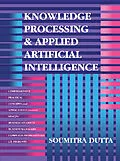Knowledge Processing and Applied Artificial Intelligence discusses the business potential of knowledge processing and examines the aspects of applied artificial intelligence technology. The book is comprised of nine chapters that are organized into five parts. The text first covers knowledge processing and applied artificial intelligence, and then proceeds to tackling the techniques for acquiring, representing, and reasoning with knowledge. The next part deals with the process of creating and implementing strategically advantageous knowledge-based system applications. The fourth part covers intelligent interfaces, while the last part details alternative approaches to knowledge processing. The book will be of great use to students and professionals of computer or business related disciplines.
Autorentext
Soumitra Dutta is the eleventh dean and professor of management and organizations in the Samuel Curtis Johnson Graduate School of Management at Cornell University. He most recently served as the Roland Berger Chaired Professor of Business and Technology. Dutta is an authority on the impact of new technology on the business world, especially social media and social networking, and on strategies for driving growth and innovation by embracing the digital economy. He is the co-editor and author respectively of two influential reports in technology and innovation -- the Global Information Technology Report (co-published with the World Economic Forum) and the Global Innovation Index (to be co-published with the World Intellectual Property Organization). Both reports have been used by several governments around the world in assessing and planning their technology and innovation policies.
Inhalt
Preface
Acknowledgments
List Of Abbreviations
Part II
Chapter 1 - Knowledge Processing and Applied Artificial Intelligence
The Evolution of Computing in Business
The Rise of Knowledge Processing
The Origins of Knowledge Processing
Philosophy
Mathematics
Computing
The Development of the Field of Artificial Intelligence
A Shift in Focus
The Evolving Sub-Fields
Governmental Funding
The Nature of Intelligence
Applied Artificial Intelligence
Knowledge Processing and Applied Artificial Intelligence
The Commercialization of Applied Artificial Intelligence
Consolidation and Growth
The Commercial Market
Moving From Data Processing to Knowledge Processing
Structure and Organization of Book
Summary
Bibliography and Suggested Readings
Notes
Part II - Acquiring, Representing, and Reasoning with Knowledge
Chapter 2 - Knowledge-Based Systems and the Acquisition of Knowledge
Digital Equipment Corporation
American Express
Campbell Soup
Structure of Knowledge-Based Systems
The Process of Building Knowledge-Based Systems
Expert Systems and Knowledge-Based Systems
Epistemology and Knowledge-Based Systems
The Definition of Knowledge
The Computer Configuration Problem
The Dimensions of Knowledge
Stages of Knowledge
Knowledge in a Knowledge-Based System
Knowledge Acquisition
Knowledge Engineer-Guided Knowledge Acquisition
Planning the Knowledge Acquisition Process
Automated Tools for Knowledge Acquisition
Induction
Steps after Knowledge Acquisition
Summary
Bibliography and Suggested Readings
Notes
Chapter 3 - Representing and Reasoning with Knowledge
Knowledge Representation Using Rules
Complex Rules and Structured Rule-Based Systems
Inference Procedures in Rule-Based Systems
Forward Chaining
Backward Chaining
A Comparison of Backward and Forward Chaining
Meta-Knowledge in Rule-Based Reasoning
Rule-Based Reasoning Under Uncertainty
Prolog: A Simple Rule-Based System
The Inference Procedure of Prolog
Benefits And Limitations of Rule-Based Reasoning
Networked Representations of Knowledge
Semantic Networks
Frame Hierarchies
Structure of Objects
Behaviors of Objects
Communication Between Objects
Comparing Frame Hierarchies and Rules
Alternative Approaches to Knowledge Representation
Blackboard Systems
Case-Based Reasoning
Summary
Bibliography and Suggested Readings
Notes
Part III - Implementing Strategic Knowledge Processing Applications
Chapter 4 - Creating Knowledge-Based Systems
Creating Rule-Based Systems
Problem Description
Problem Decomposition
Initial Prototype
Incremental Evolution
Customization
Structured Rule-Based Systems
Creating Hybrid Knowledge-Based Systems
Problem Description
Frame Hierarchy Identification
Structure and Behavior Identification
Prototyping and Incremental Evolution
Customization
Customizing the User Interface
Interfaces to Databases
Tools for Building Knowledge-Based Systems
Types of Shell Tools
Hardware Platforms for Shell Tools
Guidelines For The Selection of Shell Tools
Commercial Market for Knowledge-Based Products
The Database and Knowledge-Based Product Markets
Summary
Bibliography and Suggested Readings
Notes
Chapter 5 - Strategic And Organizational Issues in Knowledge Processing
Levels of Organizational Knowledge
Managing Knowledge in Organizations
Knowledge-Based Systems and the Management of Knowledge
Applications of Knowledge-Based Systems in Organizations
The Task Perspective
User Support Types
The Systems Perspective
Activity Types
Organizational Benefits
Organizational Hazards
Impact on Industry Structures
Managing the Development Process in Organizations
Choosing a Corporate Strategy for Knowledge Processing
Factors Affecting the Knowledge Processing Strategy
Identification of Potential Knowledge-Based Applications
Cost-Benefit Analyses of Potential Applications
Determining Feasibility of Applications
Creation of Knowledge-Based Applications
Deployment of Applications
Maintenance of Applications
Summary
Bibliography and Suggested Readings
Notes
Part IV - Intelligent Interfaces
Chapter 6 - Natural Language Processing
The Securities and Exchange Commission
Siemens-Nixdorf
Components of Natural Language Processing
The Nature of Understanding
Ambiguity in Natural Language Understanding
Approaches to Natural Language Understanding
Keyword Matching
Syntax and Semantics
Semantic Analyses
Combining Syntax and Semantics
Knowledge-Based
Conceptual Dependency Diagrams
Scripts
Understanding Multiple Sentences and Dialogs
Machine Translation
Approaches to Machine Translation
Pattern-Based Translation
Using Syntax and Semantics for Translation
Knowledge-Based Translation
Machine Translation in Industry
Evaluating Natural Language Interfaces
Commercial Tools for Natural Language Processing
Applications of Natural Language Processing
The Securities and Exchange Commission <…
